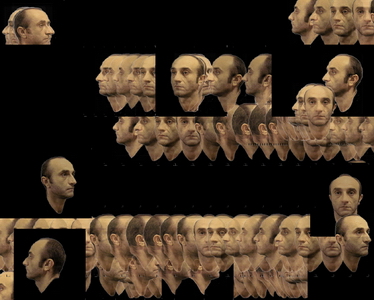
József Tasnádi, Egony, CD-ROM, 2000.
During the last 20 years, the western theoretical discourse expressed the idea of the superiority of eastern artists in different ways and within different contexts. This idea can be both attractive and problematic because, even if it might be valid, it is rather vaguely defined, which gives way to ambiguous interpretations and ideological abuses. These are mainly caused by the, conscious or not, western ambition for cultural hegemony in which the western image of the Other, whether correct or not, is projected as a norm, without real interaction, verification or questioning. The damaging consequences of such an arrogant approach are reflected, for example, in human rights policy that, although built upon a specificly western model of humanity, is generalized and implemented to the cultures for which it is totally unsuitable. Similarly superficial approach can be found in western handling of eastern art, expressed in a number of exhibitions that nominally thematize the artistic identity of the east, while in fact function either as manifestations of thorough misunderstanding or as reviews of ingratiating strategies of the ambitious eastern artists who want to get established in the western art system.
The validity of the thesis about the superiority of eastern artists could, on the other hand, be substantiated by the production such artists as József Tasnádi. Born 1960, Tasnádi graduated at the High School of Architecture (1984), got his BFA in graphics from the Ion Andreescu Academy of Fine Arts in Cluj (Romania), and MFA in graphics from the Hungarian Academy of Fine Arts in Budapest (1994). He has been exhibiting at numerous solo and group shows, and workshops.
Untroubled by the problems of interpretation of the eastern cultural identity, Tasnádi founds his poetics by questioning the crucial issues and contradictions of western philosophical, artistic and scientific thought. His works are executed in the carefully chosen and conceptually appropriate media, from graphics and installations to computer projects, all characterised by formal compactness, precision and elegance. Although it results from erudition and rich life experience, the subtle humour of his projects merges fascination and disenchantment, and maintains the distance that is, in fact, their key condition.
Tasnádi’s recent work, titled Egony, was presented in 2000 at the Mailart workshop in Graz, Austria. Egony is an interactive HTML-based multimredia CD-ROM that ironically paraphrases the ubiquous artists’ websites and portfolios. Generally used by the artists for presentation and promotion of their works, the HTML in Tasnádi’s hands turns into a discourse for demystifying the Artist’s ego.
The work is well designed and programmed, with simple but refined graphic elements on the black background. The main screen shows the title EGONY, below which rolls the quotation by agent Smith from The Matrix: “Never entrust the work of a computer to a man.” Hovered by the mouse pointer, letters of the main title transform into links: Cosmegony, Egotics, Egosophy, Egolog and Egony. The links refer to the contextual problems or aspects of (artist’s) ego, with Tasnádi’s animated portrait in the main and only role. In Egosophy, for example, the two artist’s heads rotate in a seemingly endless, varying discussion over who prefers which colour (black or white), with a lot of consideration for the opposite opinion, but without any resolution. Cosmegony is an animated planetary revolution in which one head circles the ecliptic plane around the other artist’s head. In Egolog, one head initially states that it would be best if everyone followed her/his own destiny, and to the other head’s question: “And?” there begins a frenetic exchange of phrases such as “and/or”, “and/and/or”, etc, referring to the basic logical operations in mathematics but also in everyday thinking.
By its media adequacy, Egony can be compared to the exquisite Monty Python's The Complete Waste Of Time. In both works, even though they are action-packed, there is no resolution or moral and the only change occurs on the level of symbolic processing. As opposed to the computer software that reaches its true usefulness and purpose only if commercialised, Egony is both useless and non-commercial.
This self-referential work is both charmingly amusing and serious, and this ambivalence is cunningly present in every segment of the work: visual, kinetic, narrative, contemplative. Egony is formally based in reflection but for today’s emancipated viewer it is seductive exactly because it is free of romantic mystery and often naive mystification that burdens many thematically similar Modernist works. At the same time, the reflexive key of this, as well as other József Tasnádi’s works, unconditionally surpasses dry and faint intellectualism so often present in contemporary art. Their clarity and compactness, in fact, cannot even be compared with the wasted emptiness that, as a result of existential boredom, so often troubles the art of some of his western colleagues.
Danas, Com_medi@ No. 31, 20 December, Belgrade, 2000.